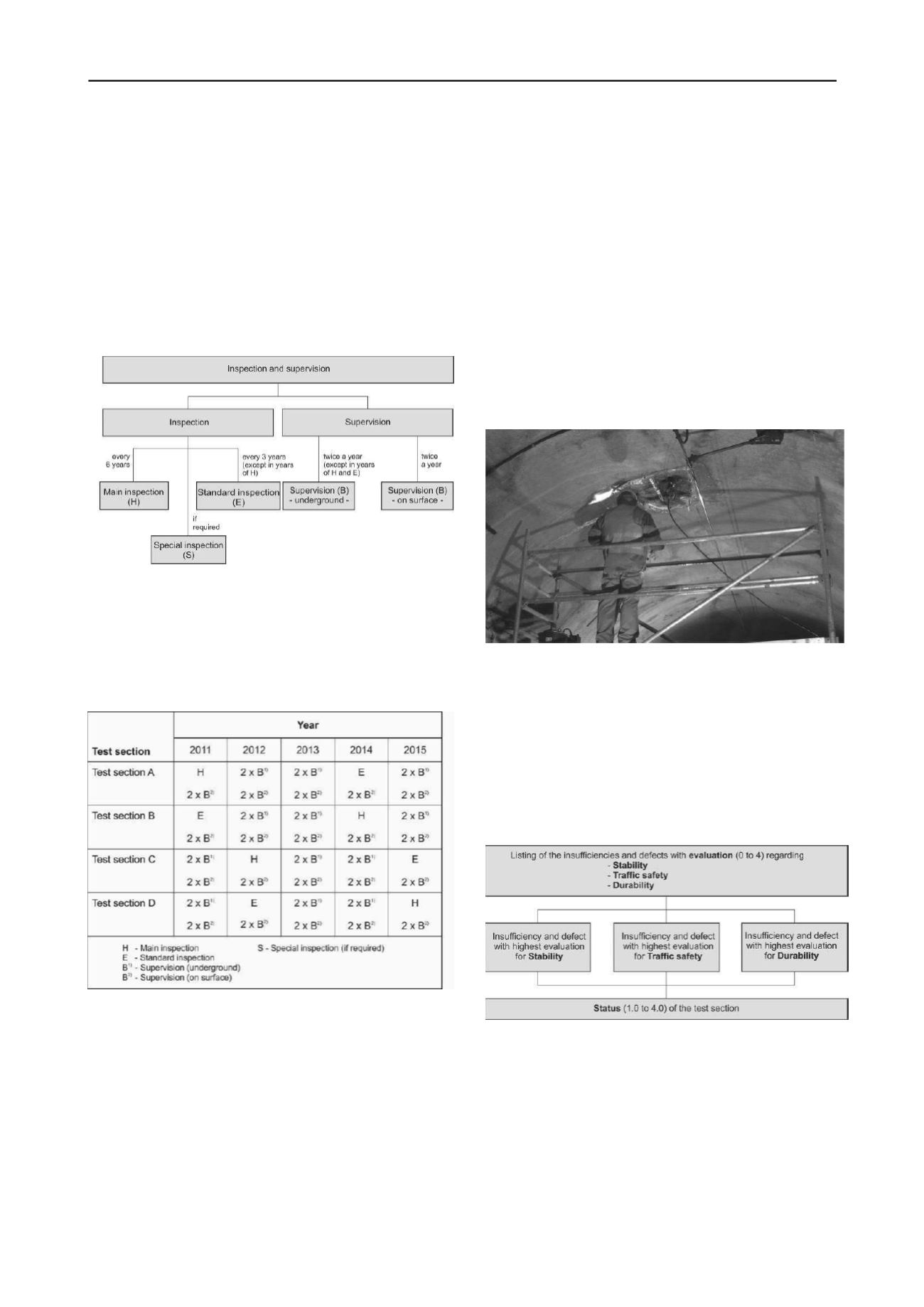
1729
Technical Committee 204 /
Comité technique 204
fire) or are necessary after standard or main inspections. Special
inspections (S) do not replace the regular inspections (E) and
(H).
The supervision (B) takes place twice a year and consists of a
quick ascent. The underground supervision (B) is done on the
traffic level of the structures and is not applied in years of
standard or main inspections (E, H). The supervision (B) on the
surface has to detect the construction works that may have an
influence on the stability, traffic safety and durability of the
underground structures. The supervision (B) on the surface is
independent to all inspections and supervisions in the
underground.
Figure 3. Engineering inspection and supervision of tunnels and
underground stations of the urban metro system in Frankfurt am Main.
Table 2 shows an example of the schedule of the modalities and
procedures of engineering inspection and supervision.
Table 2. Example of the schedule of the modalities and procedures of
engineering inspection and supervision.
3 APPLICATION IN ENGINEERING PRACTICE
The staff that is responsible for the engineering inspection and
supervision has to regard the stability, traffic safety and the
durability of the tunnels and underground stations.
Insufficiencies and defects are documented according RI-EBW-
PRÜF (Bundesministerium für Verkehr 2007). An insufficiency
is the deviance of the planned status of a structure or the applied
regulations. An insufficiency may have an effect on the
stability, traffic safety and/or durability. A defect is a
weakening or a damage of a structure that has definitively an
effect on the stability, traffic safety and/or durability.
In the case of a main inspection (Fig. 4) and if necessary in
cases of a special inspection (S) an evaluation of the status of
the structure is made regarding stability, traffic safety and
durability.
According to RI-EBW-PRÜF an extensive composition of
possible insufficiencies and defects was created by the TU
Darmstadt. This composition has benchmarks for the evaluation
of the status of a structure. The evaluation of an insufficiency or
a defect with 0 means that there is no effect on the stability,
traffic safety and durability. An evaluation of an insufficiency
or a defect with 4 means that the stability, traffic safety and/or
the durability is not given.
The durability is the most important aspect because it affects the
stability and the traffic safety. The evaluation of an
insufficiency or a defect regarding the durability has always
minimum the same number as regarding the stability and the
traffic safety.
Figure 4. Main inspection in a tunnel.
The evaluation of the insufficiencies and defects lead to a status
grade for each tunnel section resp. underground station. A status
of 1.0 to 1.4 means that stability, traffic safety and durability of
the tunnel section or underground station are given. A status
grade of 3.5 to 4.0 means that stability, traffic safety and
durability of the tunnel section or underground station are not
given. The determination of a status grade of a structure is
shown in Figure 5.
Figure 5. Determination of a status grade of a tunnel section or an
underground station.
The determination of a status grade of a structure is important
for the maintenance actions. Connected to the status grade the
time periods of the maintenance actions have to be defined. The
actions have to be carried out shortly (less than 6 month), in the
medium term (less than 3 years) or in the long term (less than 6
years). In very dangerous cases immediate actions have to be
carried out.
The results of the engineering inspection and supervision are the
basis for the planning of the maintenance actions and the


